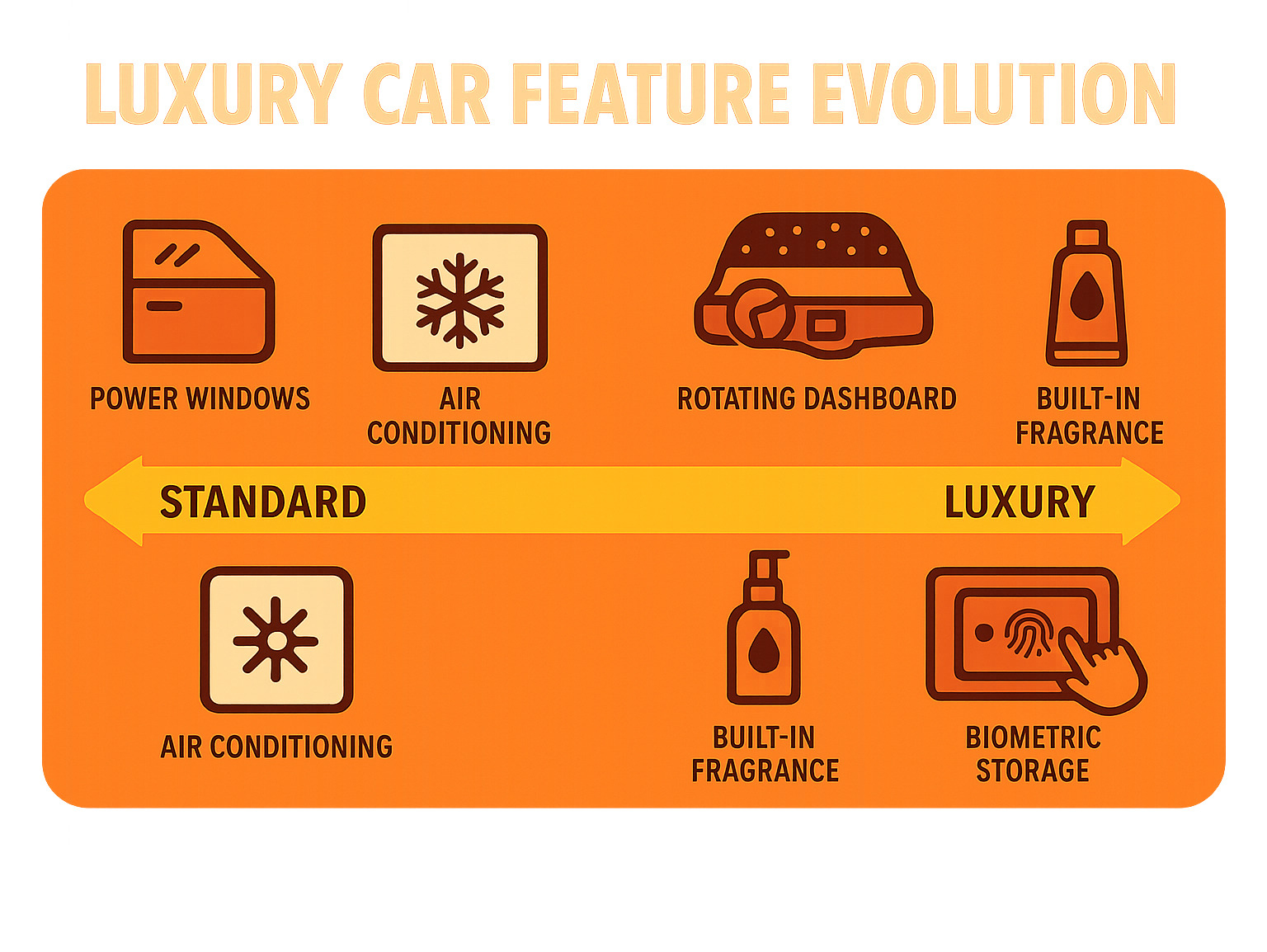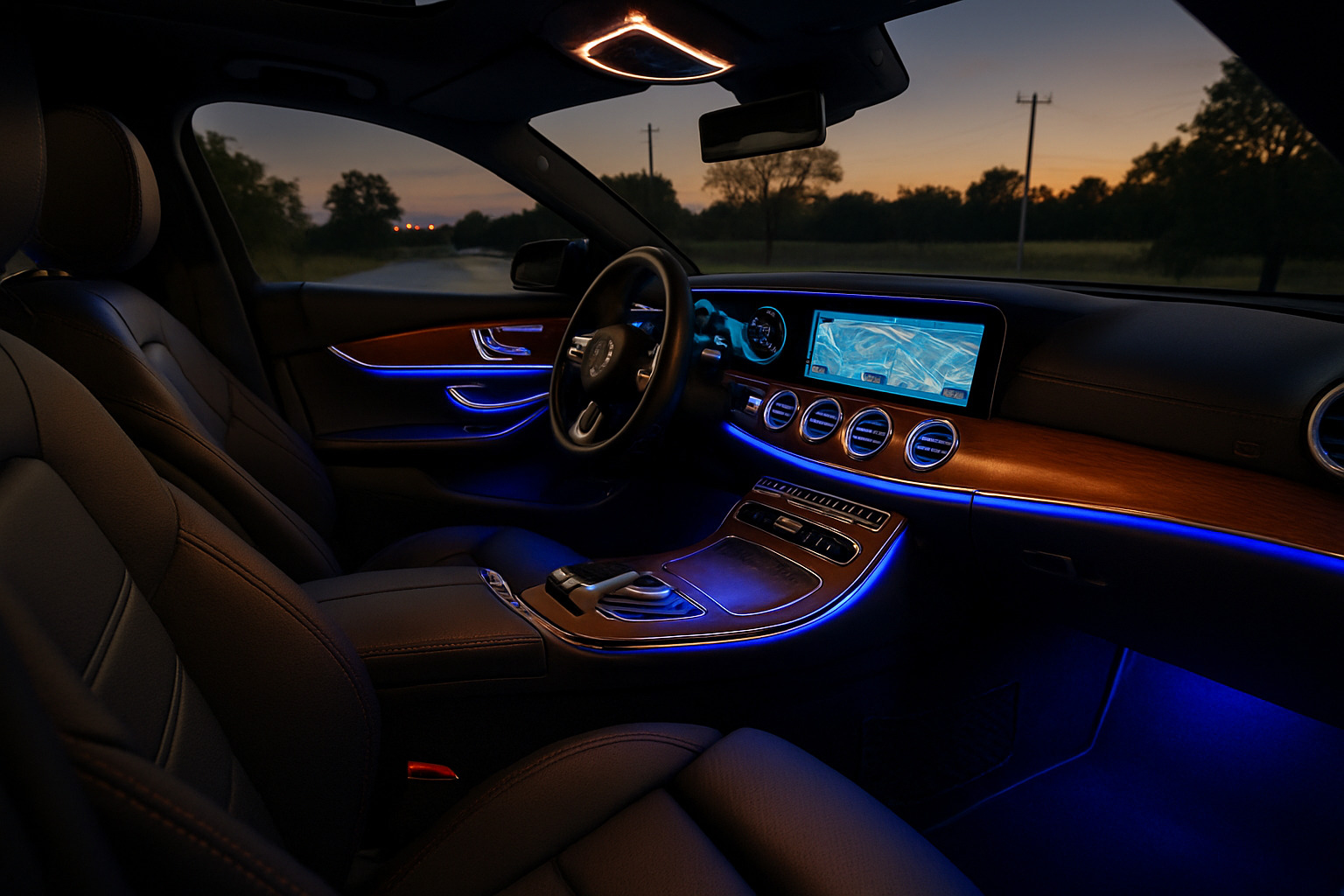luxury car features: 10 Most Impressive Innovations 2025
The Luxury Experience: Beyond Basic Transportation
Luxury car features represent the pinnacle of automotive engineering, comfort, and technology. For those wondering what sets luxury vehicles apart from standard models, here’s what defines today’s premium driving experience:
- Premium Materials: Hand-stitched leather, real wood trim, Alcantara, and even exotic materials like granite or carbon fiber
- Advanced Technology: Heads-up displays, digital cockpits, advanced driver assistance systems, and remote parking
- Comfort Innovations: Massage seats, multi-zone climate control, air purification systems, and noise cancellation
- Bespoke Options: Customizable ambient lighting, personalized interior configurations, and exclusive color options
- Prestige Features: Starlight headliners, rotating dashboard displays, built-in fragrances, and biometric secure storage
Luxury cars aren’t just transportation—they’re rolling sanctuaries designed to create exceptional experiences. As Bentley’s design director once noted, “Luxury is about creating something beyond necessity.”
The definition of luxury in automobiles has evolved dramatically over the decades. What was once considered the height of opulence—power windows and air conditioning—is now standard equipment in economy cars. Today’s luxury features push boundaries by focusing on wellness, connectivity, and personalization.
Modern luxury vehicles distinguish themselves through sensory experiences and technological innovation. The Rolls-Royce starlight headliner embeds up to 1,600 fiber-optic lights in the roof liner to simulate a night sky. Mercedes-Maybach offers active perfume dispensers that diffuse signature scents throughout the cabin. BMW’s 7 Series provides a remote parking feature controlled entirely from the key fob.
The luxury car market continues to innovate in response to changing consumer expectations. While performance remains important, the focus has shifted toward creating environments that pamper occupants, anticipate their needs, and provide seamless connectivity to their digital lives.

Luxury car features terms you need:
– luxury car interiors
– luxury car technology
What Defines Modern Luxury Car Features?
The line between luxury and mainstream vehicles has blurred in fascinating ways recently. While that prestigious badge on the hood still turns heads, today’s luxury car features go far beyond logos—they create an entire sensory experience that transforms your daily commute into something extraordinary.
Modern luxury cars excel at one thing above all: isolating you from the chaos of the outside world. Take Audi’s A8 with its almost magical predictive suspension system. Using cameras to scan the road ahead, it prepares the suspension before you even feel that pothole. As one automotive journalist perfectly described it, “It’s like floating on a cloud.” This isn’t transportation; it’s transcendence.
| Feature Category | Luxury Vehicle Standard | Mainstream Vehicle Equivalent |
|---|---|---|
| Interior Materials | Hand-stitched Nappa leather, real wood, metal inlays | Leatherette, plastic with wood-effect trim |
| Suspension | Adaptive air suspension with predictive control | Standard or sport-tuned coil springs |
| Audio | 20+ speaker systems with active noise cancellation | 6-10 speaker systems |
| Customization | Bespoke color/material programs with millions of combinations | Limited color/trim packages |
| Climate Control | 4+ zone climate with fragrance, ionizer, HEPA filtration | Dual-zone automatic climate control |
| Seating | 20+ way adjustable with heating, cooling, massage | 8-way power with optional heating |
What truly separates a true luxury vehicle from a well-equipped mainstream model isn’t just what you can see—it’s how the car anticipates your needs before you even realize them. The Mercedes S-Class doesn’t just remember your seat position; its AI learns your preferences for temperature, music, and even massage settings, automatically adjusting everything based on who’s driving and the time of day.
“Luxury today isn’t just about what you can see and touch,” explains a senior BMW designer. “It’s about creating experiences that engage all the senses and make every journey memorable.”
Luxury Car Technology remains the ultimate differentiator, with flagship models serving as rolling laboratories where tomorrow’s innovations make their debut before eventually trickling down to mainstream vehicles years later.
Evolution of luxury car features and buyer expectations
The story of luxury car features reads like a fascinating century-long journey through automotive innovation. When the 1908 Rolls-Royce Silver Ghost first set the standard for luxury transportation, simply having a reliable, quiet engine was considered the height of opulence. Fast forward to the Roaring Twenties, and features like electric starters, interior lighting, and heaters felt like science fiction made real.
The post-war era brought power everything—windows, seats, steering, brakes—features that transformed the driving experience. Air conditioning, that blessed relief we now take for granted, was once the must-have luxury feature of the 1950s and 60s. By the time the 70s and 80s rolled around, onboard computers and early driver assistance systems began appearing in only the most exclusive models.
For decades, the front-engine, rear-wheel-drive layout (FR) dominated luxury car design, prioritizing that perfect balance of comfort, handling, and space for larger engines. Today, that rulebook is being completely rewritten by electric vehicles. Just look at the Lucid Air or Mercedes EQS—without a bulky combustion engine taking up space, designers have reimagined what a luxury cabin can be.
Buyer expectations have evolved just as dramatically. Back in the 90s, a CD changer and leather seats might have been enough to impress. Today’s luxury customers demand technology that seamlessly integrates with their digital lives, features that improve their wellbeing, and personalization options that make their vehicle as unique as they are. As one industry analyst perfectly summed it up: “Luxury car buyers aren’t just purchasing transportation—they’re investing in a lifestyle statement and a personal sanctuary.”
The constant trickle-down of technology creates an interesting challenge for luxury brands. Features that once made jaws drop in an S-Class Mercedes—like adaptive cruise control—now appear in compact Hyundais. This forces luxury manufacturers to continuously push boundaries further to maintain that all-important premium position.
Why luxury car features matter for status and satisfaction
Beyond the obvious benefits of comfort and convenience, luxury car features deliver something far more powerful—emotional rewards that connect deeply with owners. There’s a genuine psychological satisfaction that comes from owning something exclusive and crafted with extraordinary attention to detail.
A luxury vehicle serves as a powerful status symbol—tangible proof of achievement and success. When a Bentley owner opens their door to reveal illuminated treadplates with their personal monogram, or a Rolls-Royce client gazes up at their custom-configured starlight headliner (designed to match the night sky on their birthday), they experience a sense of pride that goes far beyond simple transportation.
“Owning any vehicle is a luxury in itself,” notes one automotive psychologist, “but a luxury car takes that opulence further, creating moments of delight with each interaction.”
These emotional connections explain why luxury car owners often develop such fierce brand loyalty. The satisfaction that comes from thoughtful touches—like the Mercedes-Benz “Gentleman Function” that automatically adjusts the front passenger seat when the rear door opens—creates lasting impressions that strengthen the bond between owner and vehicle.
As one Rolls-Royce owner eloquently put it: “Every time I see the umbrella tucked into my Phantom’s door, I’m reminded of the thoughtfulness that went into designing this car. It’s not just transportation; it’s a companion that anticipates my needs.”
Sensory & Wellness Features: Turning the Cabin into a Spa
Remember when luxury cars were just about leather seats and wood trim? Those days are long gone. Today’s high-end vehicles have transformed into rolling wellness retreats that pamper you from the moment you slide behind the wheel. These luxury car features now engage all your senses, creating an experience that might actually leave you more refreshed after your commute than before it.

Let’s talk about the Rolls-Royce starlight headliner – possibly the most magical feature in any modern car. Picture this: you’re driving home after a long day, you glance up, and there’s a perfect night sky twinkling above you. Each one is handcrafted with between 800 and 1,600 fiber-optic lights, taking craftspeople up to 17 hours to complete. Some owners even request the exact star pattern from their birthday or anniversary. As one automotive journalist put it, “Looking up at an artificial constellation in a car roof feels like stargazing on a perfect date. It transforms mundane commutes into magical experiences.”
Your sense of touch isn’t forgotten either. Today’s massage seats make your old living room recliner seem positively primitive. The Mercedes-Benz S-Class offers ten different massage programs, including a “hot stone” treatment that combines heating elements with precisely targeted pressure points. Feeling stiff on a long drive? BMW’s “Vitality Programme” guides rear passengers through seated exercises to improve circulation. Your car is literally your personal physical therapist now.
Peace and quiet have reached new heights too. Bentley creates what they call a “vault-like interior” using laminated acoustic glass and active noise cancellation. Rolls-Royce goes even further, incorporating over 220 pounds of sound insulation and engineering components like “whisper-quiet” air conditioning systems. The outside world simply disappears when you close the door.
Even your sense of smell gets the luxury treatment. Mercedes-Benz’s AIR-BALANCE package includes a glove box-mounted atomizer that gently diffuses signature scents throughout the cabin. BMW offers similar systems with fragrances designed for different moods – energizing for morning commutes, perhaps, or relaxing for the drive home. It’s like having a personal aromatherapist riding shotgun.
These features aren’t just about showing off, either. According to scientific research on in-cabin wellness, comfortable, stress-free environments actually reduce driver fatigue and improve reaction times. As one wellness expert who consults for automotive brands explained, “The luxury car cabin has become a sanctuary from the outside world. These features aren’t frivolous—they’re designed to ensure drivers arrive at their destinations refreshed and alert.”
For more details on how automakers are changing interiors into personal sanctuaries, check out our guide to Luxury Car Interiors. The evolution continues with seats that automatically adjust to optimize your posture and climate systems that maintain ideal humidity levels for your skin and respiratory health.
Top sensory luxury car features for US and India
What constitutes luxury varies widely depending on where you live. The features that make Americans swoon might leave Indian buyers scratching their heads, and vice versa.
In the United States, space and comfort reign supreme. American luxury buyers are absolutely obsessed with ventilated and cooled seats. As one Florida-based luxury dealer told me, “In states like Florida and Texas, cooled seats aren’t a luxury—they’re a necessity for eight months of the year.” Nobody wants to slide into a car with leather seats that have been baking in the sun all day.
Americans also love their advanced cruise control and driver assistance systems. With our sprawling highway networks, anything that reduces fatigue during those long interstate drives is highly valued. The Lincoln Navigator’s 30-way adjustable “Perfect Position” seats with individual thigh supports have become a hit with buyers who regularly tackle long-distance drives.
Cross the ocean to India, and priorities shift dramatically. Multi-zone climate control systems with dedicated rear controls top the list there, largely because many luxury car owners employ chauffeurs. The backseat experience matters enormously. Advanced air purification systems with PM2.5 filters have become must-have features in urban areas where air quality is a daily challenge.
“Indian luxury car buyers expect features that make sense for our roads and climate,” explains a Mumbai-based automotive consultant. “Strong air conditioning, good ground clearance, and advanced noise insulation are more important than some of the flashier features popular in Europe.”
Indian buyers also place high value on rear-seat entertainment systems and connectivity features. The popularity of Mercedes’ “Gentleman Function” – which automatically adjusts the front passenger seat to create more legroom when the rear door opens – perfectly illustrates the chauffeur-driven nature of luxury car use in India.
Interestingly, while panoramic sunroofs are extremely popular with American buyers, they’re often considered unnecessary in India’s hot climate. As one forum commenter bluntly put it, “Panoramic sunroofs are overrated and unnecessary for India. They let in heat and are rarely used.”
Both markets do share some common ground, though. High-quality audio systems and seamless smartphone integration are universally appreciated, though Americans tend to accept wireless charging more enthusiastically than their Indian counterparts, who often describe the technology as “not mature enough to be useful yet.”
Understanding these regional differences isn’t just interesting – it’s essential for anyone shopping for a luxury vehicle to focus on the luxury car features that will actually improve their daily driving experience rather than just ticking boxes on a spec sheet.
Cutting-Edge Tech & Connectivity
Technology has become the new battleground for luxury automakers, with digital interfaces and connectivity features serving as key differentiators. Today’s luxury car features include innovations that would have seemed like science fiction just a decade ago.

Remember the first time you used a smartphone and thought, “Wow, this changes everything”? That’s the feeling you get sitting behind the wheel of a Mercedes-Benz with its MBUX Hyperscreen. This jaw-dropping 56-inch curved OLED display stretches across the entire dashboard, seamlessly blending driver information, entertainment, and passenger controls into one visual masterpiece. What makes it truly special isn’t just its size but its brains – the system actually learns your habits and anticipates your needs.
“The first time you experience the Hyperscreen anticipating your needs—like automatically calling a contact you regularly speak with on Tuesday mornings—it feels like the car is reading your mind,” one technology journalist told me recently.
Voice assistants in luxury vehicles have grown up, too. They’ve evolved from those frustrating early systems that barely understood “Call Mom” to sophisticated AI companions that get your natural speech patterns. BMW’s Intelligent Personal Assistant responds to casual comments like “Hey BMW, I’m tired” by launching an “Energize” program – adjusting your lighting, music, and climate to help keep you alert. It’s like having a personal wellness coach built into your dashboard.
Remember when cars just got older and more outdated with time? Those days are disappearing thanks to over-the-air (OTA) updates. Tesla pioneered this smartphone-like approach to car ownership, but traditional luxury brands have caught up quickly. Now your Porsche Taycan can receive performance improvements and new features while sitting in your garage overnight. You literally wake up to a better car than the one you parked the night before.
The connectivity revolution extends beyond the vehicle itself. The Mercedes-Benz and Google deal integrates Google Maps directly into Mercedes vehicles, delivering pinpoint navigation accuracy and real-time traffic updates. As Mercedes’ CEO proudly noted, “This partnership will give our customers the most cutting-edge navigation experience available.”
For music lovers, today’s luxury vehicles create concert-hall experiences on wheels. My personal favorite touch? Bang & Olufsen’s motorized tweeters in Aston Martin and Audi models. These speakers physically rise from the dashboard when you turn on the system – a bit of mechanical theater before the audio performance even begins. One reviewer described them perfectly: “They rise like futuristic mushrooms from the dash, creating a spectacle before you even hear the first note.”
The rapid evolution of Advanced Car Technology shows no signs of slowing, with luxury brands investing heavily in digital experiences that grow and improve throughout your ownership journey.
Luxury car features that are reshaping the driving interface
The traditional car interior—with its physical buttons, gauges, and controls—is undergoing a radical change led by innovations in luxury car features. These changes aren’t merely aesthetic; they’re fundamentally reshaping how we interact with vehicles.
Remember when a “digital dashboard” meant a calculator-style display showing your speed? Today’s digital cockpits offer fully customizable environments that adapt to your needs. Audi’s Virtual Cockpit lets you switch between traditional gauge layouts and an expansive navigation view that minimizes everything else. The Lucid Air takes this concept even further with a curved display that can actually slide away when not needed, creating a cleaner, more zen-like dashboard experience.
“The best digital interfaces don’t just replicate analog controls on a screen,” explained a UX designer who works with luxury automakers over coffee last month. “They rethink the entire interaction model based on what’s possible with digital technology.”
Touch a button in a modern luxury car, and you’ll notice something special – subtle vibrations confirming your input. This haptic feedback technology has become increasingly sophisticated, especially in vehicles like the Bentley with its rotating dashboard. This mechanical marvel smoothly transitions between three different faces: neat wood veneer for a classic look, analog dials for traditional driving, or a digital touchscreen for modern connectivity. What looks simple is actually a 40-part mechanism that even varies its motor speed based on cabin temperature to ensure smooth operation whether you’re in Alaska or Arizona.
Driving through an unfamiliar city becomes almost foolproof with augmented reality navigation. The Mercedes-Benz S-Class quite literally shows you the way by projecting directional arrows onto the road ahead via its heads-up display. Meanwhile, BMW’s iDrive controller has evolved to recognize your handwriting on its touchpad surface – just sketch letters and numbers rather than hunting and pecking on an on-screen keyboard.
Remember when “gesture control” seemed like something from a sci-fi movie? BMW pioneered this technology, allowing drivers to adjust volume, accept calls, or steer menus with simple hand movements. While the first versions felt a bit gimmicky, the technology has matured into something genuinely useful and surprisingly intuitive.
“The goal isn’t technology for technology’s sake,” a senior Audi engineer told me at a recent demo. “It’s about creating interfaces that feel natural and reduce cognitive load, allowing drivers to focus on the road while still accessing the features they need.”
The digital revolution in luxury cars isn’t just changing how we drive – it’s redefining what we expect from our vehicles. They’re becoming extensions of our digital lives, personal assistants, and wellness spaces all wrapped in beautiful packages that just happen to take us places.
Safety & Semi-Autonomous Systems
Safety features have long been a hallmark of luxury vehicles, with innovations appearing first in flagship models before trickling down to mainstream vehicles. Today’s luxury car features go beyond passive protection to actively prevent accidents and reduce driver stress.
Adaptive cruise control has evolved from simple speed maintenance to sophisticated systems that can handle stop-and-go traffic without driver intervention. The Mercedes-Benz Drive Pilot system, available in the S-Class, represents one of the first commercially available Level 3 autonomous driving systems, allowing drivers to take their hands off the wheel and eyes off the road in certain conditions.
Lane assistance technology has progressed from basic warnings to active steering intervention. Audi’s active lane assist not only keeps the vehicle centered but also adapts to different road widths and driving styles. Some systems can now detect construction zones and adjust their behavior accordingly.
Blind-spot monitoring has expanded beyond simple indicator lights to include active intervention. If a Volvo XC90 driver attempts to change lanes when another vehicle is in their blind spot, the system will gently steer the car back into its lane to prevent a collision.
“These systems create a safety cocoon around the vehicle,” explains a safety engineer. “They’re constantly monitoring 360 degrees around the car, identifying potential hazards faster than any human could.”
The 360-degree camera systems in luxury vehicles have transformed from low-resolution parking aids to high-definition surround-view monitors. BMW’s system creates a virtual 3D model of the vehicle and its surroundings, allowing drivers to see their car from any angle—even from outside the vehicle—on the central display. Range Rover’s “transparent hood” technology uses cameras to show what’s directly beneath the front of the vehicle, making off-road navigation easier.
According to Safest Cars research, luxury vehicles consistently lead safety ratings due to their early adoption of advanced technologies. As one safety expert notes, “Luxury brands have the research budgets and price points to introduce technologies that might be too expensive for mainstream models initially.”
From flagship sedans to luxury SUVs
The migration of luxury car features from traditional sedans to SUVs represents one of the most significant shifts in the luxury market over the past decade. By 2004, 30% of major luxury brands’ U.S. sales were SUVs, and that percentage has only increased since then.
Platform sharing has enabled luxury brands to transfer sophisticated technologies from their flagship sedans to their SUV lineups. The Audi Q8 shares much of its technology with the A8 sedan, including the adaptive air suspension, mild hybrid system, and digital cockpit. Similarly, the BMW X7 incorporates many of the comfort and technology features from the 7 Series.
This transition hasn’t been without challenges. The inherent weight and higher center of gravity of SUVs create engineering problems for delivering the ride quality expected in luxury vehicles. Bentley addressed this with the Bentayga by developing a 48-volt active anti-roll system that virtually eliminates body roll during cornering while maintaining a plush ride on straight roads.
“The modern luxury SUV must perform a remarkable balancing act,” explains a vehicle dynamics engineer. “It needs to provide the commanding seating position and versatility of an SUV while delivering the refinement of a luxury sedan.”
The Range Rover has perhaps best exemplified this evolution. Its latest generation incorporates a noise-cancellation system that monitors wheel vibrations and engine noise, then generates opposing sound waves through the audio system to create a serene cabin environment. This technology was previously found only in luxury sedans.
Rolls-Royce took the ultimate step with the Cullinan, bringing its signature coach doors and starlight headliner to the SUV segment. As one automotive journalist noted, “The Cullinan doesn’t feel like a luxury SUV—it feels like a Rolls-Royce that happens to have higher ground clearance.”
The shift toward luxury SUVs has also influenced feature development, with increased focus on off-road capability paired with luxury. The Mercedes-Maybach GLS includes a “Curve” driving mode that actively leans the vehicle into corners, reducing perceived lateral forces for passengers—a feature designed specifically for the higher seating position of an SUV.
Bespoke Customization & Material Craft
True luxury extends beyond standard features to include personalization and craftsmanship that make each vehicle unique. Luxury car features in the bespoke field allow owners to create vehicles that reflect their individual taste and personality.

Ever seen a car interior adorned with metal foil threads mounted on traditional Japanese paper? Lexus offers this extraordinary option with its Haku door trim, where master artisans hand-apply each delicate piece onto washi paper. At $1,200, it’s surprisingly one of the more accessible truly bespoke options, bringing ancient Japanese craftsmanship into modern luxury vehicles.
For those with more exotic tastes, Mercedes-Maybach’s Black Galaxy granite trim harvested from India and polished to mirror perfection creates an unexpected interior element. While stone might seem impractical for a car, one designer quipped, “It works because there’s enough torque to take care of anything.” The visual impact of natural stone catching the light as you drive simply can’t be replicated with synthetic materials.
Bentley’s Mulliner division takes personalization to heartwarming extremes. Their craftspeople can match any color a client desires—from a favorite lipstick shade to the exact hue of a beloved pet. I particularly love the story of one Bentley client who requested wood veneer from a tree on their family estate, creating a literal connection between their home and vehicle. Every time they touch the dashboard, they’re touching a piece of their heritage.
Carbon fiber has evolved from purely functional to genuinely artistic in today’s luxury vehicles. Aston Martin transforms this high-performance material into jewelry with their distinctive twill carbon fiber weave pattern. What began as a racing material now adorns luxury interiors with visual texture while maintaining its incredible strength.
The gentle art of hand-stitching leather remains a hallmark of luxury craftsmanship, with some vehicles featuring over 400,000 individual stitches. Next time you see a Bentley steering wheel, consider this: those perfect contrast stitches required more than three hours of focused handwork by a master craftsperson. As one Bentley artisan warmly noted, “We’re not just building cars; we’re creating heirlooms.”
Perhaps nothing captures the spirit of automotive personalization better than Rolls-Royce’s Phantom Gallery—a glass-enclosed space in the dashboard where owners can commission unique artwork. One client installed a gold-plated 3D-printed map of their DNA, while another showcased hand-painted silk roses. It’s literally a museum-quality display case for your personal artistic expression.
Looking ahead, Luxury Car Trends for 2023 show growing interest in sustainable luxury materials. Brands are exploring alternatives to traditional leather and rare woods that maintain exclusivity while addressing environmental concerns—think cactus leather and reclaimed timber with fascinating origin stories.
The role of personalization programs
Factory personalization programs have blossomed from simple color selections into comprehensive bespoke services creating virtually one-of-a-kind vehicles. These programs allow luxury car features to be custom to individual tastes while maintaining manufacturer quality standards.
Porsche Exclusive Manufaktur stands as one of the most established personalization programs, offering everything from custom paint colors to leather-wrapped air vents. I love their attention to detail—they’ll even color-match interior elements to your favorite watch or handbag. As one Porsche executive warmly explained, “Our clients don’t want a Porsche like everyone else’s—they want their Porsche.”
Ferrari’s Tailor Made program takes a more curated approach, dividing offerings into three distinct collections: Scuderia (racing-inspired), Classica (heritage-focused), and Inedita (innovative and unconventional). Even within these themes, clients can explore truly unique options. One passionate client commissioned seats upholstered in the exact same denim as their favorite jeans—bringing personal comfort to a whole new level.
The digital configurator has revolutionized how we approach personalization. Bentley’s digital playground offers over 10 billion possible combinations for the Continental GT alone. Using sophisticated ray-tracing technology, these tools show how different materials will catch the light at various times of day, helping clients visualize their creation before it exists.
“The digital configurator is just the starting point,” explains a customer experience director at a luxury brand. “The real magic happens when clients visit our ateliers and work directly with our designers to create something truly personal.” These in-person experiences often include material samples, design sketches, and conversations about the client’s lifestyle and preferences.
For those seeking the ultimate expression of individuality, brands like Rolls-Royce and Bentley offer coachbuilding services that go beyond personalization to create entirely bespoke bodies. The Rolls-Royce Boat Tail—valued at approximately $28 million with only three built—features a rear deck that opens like a butterfly to reveal a hosting suite complete with champagne cooler and parasol. It’s essentially a yacht for the road.
These personalization programs aren’t merely marketing gimmicks—they represent significant revenue and emotional connection. Porsche estimates customers spend an average of $15,000 on personalization options for the 911, with some investing over $100,000 on bespoke features. The result isn’t just a car; it’s a deeply personal statement that reflects the owner’s identity and passions.
Value & Ownership: New vs Used Luxury
The allure of luxury car features often comes with a substantial price tag, but understanding depreciation patterns can make luxury more accessible. New luxury vehicles can lose as much as 50% of their value within three years—a sobering statistic for first owners but an opportunity for those entering the luxury market through pre-owned vehicles.

This depreciation isn’t created equal across all luxury brands. That sleek German sedan might shed value faster than a limited-production SUV from a prestigious marque. As one automotive financial analyst put it with a wink, “The first owner pays for the privilege of having the latest and greatest, while the second owner often gets 90% of the luxury experience for 60% of the original price.” It’s like waiting for the paperback instead of buying the hardcover—same story, lower price.
Tax thresholds play a fascinating role in how manufacturers package their luxury offerings. Take Australia, where the luxury car tax kicks in at around AU$66,000 (US$50,000) for standard vehicles and AU$76,000 (US$57,000) for fuel-efficient models. You’ll notice car companies often carefully position their vehicles and feature packages just below these thresholds—a little financial dance that savvy buyers can use to their advantage.
The maintenance equation is where many luxury dreams meet reality. That air suspension giving you the floating-on-air feeling? It might cost $4,000 to replace when it eventually fails. Even more eye-watering is the humble proximity key in high-end luxury vehicles—replacing one can run up to $12,000. That’s not a typo! Suddenly that extended warranty looks less like an upsell and more like financial wisdom.
Certified pre-owned (CPO) programs offer a comforting middle ground for those dipping their toes into luxury waters. These programs typically include thorough inspections, warranty coverage, and perks like roadside assistance. It’s like having a safety net while still enjoying the circus of luxury car ownership. Many CPO programs even provide loaner vehicles during service appointments, ensuring you’re never without that luxury experience you’ve come to expect.
There’s also a growing sustainability angle to consider. Buying pre-owned extends a vehicle’s useful life and reduces the environmental impact of manufacturing new cars. Some forward-thinking luxury brands now offer remanufactured parts programs that rebuild components to original specifications—keeping quality high while reducing waste. It’s guilt-free luxury, if you will.
For those dreaming of high-performance thrills without the new-car financial spills, Affordable Luxury Sports Cars have become increasingly accessible through the pre-owned market. Yesterday’s six-figure dream car might be today’s attainable reality.
Maximizing long-term value
Strategic approaches to luxury car features can help owners maximize both enjoyment and financial value throughout their ownership experience. Think of it as planning for both the honeymoon and the marriage when it comes to your relationship with a luxury vehicle.
Extended warranties become particularly valuable for vehicles with sophisticated technology. As one luxury car service manager explained with refreshing honesty, “The air suspension that gives you that magic carpet ride might cost $4,000 to replace, but it’s covered under most extended warranty programs.” That peace of mind is a luxury feature in itself.
When selecting features for a new luxury vehicle, consider their impact on resale value. That unique purple leather interior might bring you personal joy, but it could limit your pool of potential buyers down the road. On the flip side, widely desirable features like premium audio systems, driver assistance packages, and heated and ventilated seats typically return a portion of their cost at resale time.
“Stick with the features that improve the daily experience,” advises a luxury car broker with years of experience. “The fragrance dispenser or refrigerated center console might seem cool now, but the next buyer might not share your enthusiasm for chilled beverages on demand.”
Residual value trends vary significantly across luxury segments. Electric luxury vehicles currently experience higher depreciation than their combustion counterparts, though this pattern may shift as EV infrastructure improves and battery technology advances. Limited-production models often maintain value better, sometimes even appreciating if they achieve collector status—turning your indulgence into an investment.
Maintenance records become particularly important for luxury vehicles. They’re like a clean bill of health for your car, providing reassurance to future buyers about proper care. Many luxury brands now offer digital service records that stay with the vehicle, creating an unbroken chain of documentation that can significantly boost resale value.
Some manufacturers offer transferable maintenance packages that can be passed along to subsequent owners, adding value at resale time. These programs typically cover scheduled maintenance for a set period, removing uncertainty about maintenance costs for the next owner—a thoughtful parting gift to the future caretaker of your prized possession.
“The smartest luxury buyers think about the exit strategy when they make the purchase,” notes one automotive investment advisor with a practical tone. “They select models with proven reliability, choose widely appealing features and colors, and maintain comprehensive service records—all of which protect residual value.” It’s about enjoying the journey while keeping an eye on the destination.
Frequently Asked Questions about Luxury Car Features
What makes a car a luxury vehicle?
When you slide behind the wheel of a true luxury car, you know it immediately. That special feeling comes from a perfect blend of premium materials, cutting-edge technology, exceptional comfort, and brand prestige that mainstream vehicles simply can’t match.
Luxury car features go far beyond basic transportation needs. Think of hand-stitched leather that feels buttery-soft to the touch, genuine wood trim harvested from sustainable forests, and metal accents that have been polished by skilled craftspeople. These tangible elements create an environment that feels special every time you enter the vehicle.
But luxury is also about the experiences you can’t immediately see or touch. It’s that whisper-quiet cabin that makes conversations effortless even at highway speeds. It’s the way the suspension seems to read the road ahead, smoothing out imperfections before you feel them.
“A luxury car doesn’t just take you from point A to point B—it transforms the journey into an event,” as one luxury brand executive perfectly put it.
The definition keeps evolving, too. Features that were once exclusive to flagship luxury models—like heated seats and touchscreen infotainment—now appear in many mainstream vehicles. This constant migration forces luxury brands to innovate continuously, creating new experiences that maintain that special distinction between luxury and everyday transportation.
Which luxury features hold their value the longest?
Not all luxury car features retain their value equally when it’s time to sell or trade in your vehicle. If you’re thinking strategically about which options to select, some consistently offer better returns than others.
Safety technologies typically age very well. Advanced driver assistance systems like adaptive cruise control and automatic emergency braking remain desirable for years because they deliver tangible safety benefits that never go out of style. A pre-owned luxury car with a comprehensive safety package will almost always command a premium over an identical model without these features.
Comfort features with broad appeal also maintain strong value. Heated and ventilated seats, panoramic sunroofs, and premium audio systems consistently return a good portion of their original cost. As one luxury car dealer told me with a smile, “Heated seats might cost $500 as an option, but they can add $300-400 to the resale value three years later—a much better percentage return than most options.”
For performance-oriented luxury vehicles, meaningful mechanical upgrades tend to hold value impressively well. Sport packages with upgraded suspension components, performance brakes, and more powerful engines attract enthusiast buyers willing to pay a premium in the pre-owned market.
On the flip side, highly personalized choices and bleeding-edge technologies often depreciate more quickly. That purple leather interior might perfectly match your favorite handbag, but it could significantly limit your pool of potential buyers down the road. Similarly, first-generation versions of new technologies may feel outdated sooner than more established features.
“The best-value luxury features are those that improve the everyday driving experience without being overly complex or maintenance-intensive,” a veteran luxury vehicle appraiser shared with me. “A premium audio system will be appreciated by virtually every buyer, while an early version of gesture control might feel gimmicky after a few years.”
Are luxury car features now common in mainstream models?
The line between luxury and mainstream vehicles has definitely blurred in recent years. Many features that once made luxury cars special have indeed trickled down to more affordable models, though there are usually meaningful differences in how they’re executed.
This “democratization of luxury” means you can now find heated seats, large touchscreens, and even advanced safety features like blind-spot monitoring in vehicles across almost every price point. My neighbor’s compact hatchback has features that would have been exclusive to an S-Class Mercedes just fifteen years ago!
But look a little closer, and the differences become apparent. A mainstream vehicle might offer heated seats that simply turn on and off, while a luxury version provides multiple heat zones, rapid warming elements, and intelligent programming that remembers your preferences based on the outside temperature.
“It’s like the difference between a basic smartphone and a flagship model—they both make calls and run apps, but the experience is entirely different,” an automotive engineer explained to me over coffee at a recent auto show.
Luxury brands stay ahead by continuously introducing innovations before they can reach mainstream vehicles. Current examples include Mercedes-Benz’s augmented reality navigation that overlays directional arrows on a live street view, BMW’s ability to remotely park your vehicle from outside the car, and Audi’s predictive active suspension that reads the road ahead.
While the feature gap has narrowed, luxury vehicles still deliver a more cohesive, refined experience that mainstream brands can’t quite match without compromising their value proposition. The difference is in the details—how everything works together seamlessly, the quality of materials, and those special touches that make you smile every time you drive.
Conclusion
The world of luxury car features is changing faster than ever, but not just for the sake of adding more bells and whistles. Today’s most impressive luxury vehicles blend cutting-edge technology with traditional craftsmanship to create experiences that feel both innovative and timeless.
Have you noticed how many luxury cars now feel more like wellness retreats on wheels? This isn’t accidental. From seats that massage away tension to air purification systems that keep you breathing clean air in congested cities, luxury vehicles have become sanctuaries that actively improve your wellbeing. Soon, your car might even monitor your heart rate or stress levels, automatically adjusting lighting, temperature, and even fragrance to help you relax after a tough meeting.
The magic happens when digital innovation meets traditional craftsmanship. Take Bentley’s rotating dashboard – a perfect example of this balance. At the touch of a button, it transforms from a sleek touchscreen to handcrafted wood veneer with neat analog gauges. It’s technology that respects tradition, giving drivers the choice between digital immersion or digital detox.
“My car should be as unique as I am” has become the mantra of luxury car buyers. Bespoke programs have exploded in popularity, allowing owners to create vehicles that truly reflect their personality. One Rolls-Royce client commissioned a starlight headliner that recreated the night sky exactly as it appeared on their birthday – the ultimate personal touch.
Sustainability has shifted from an afterthought to a central focus in luxury vehicles. Electric powertrains from brands like Lucid and Rimac aren’t just environmentally responsible – they’re delivering performance and refinement that surpass traditional engines. Luxury interiors now showcase sustainable materials that don’t compromise on sensory appeal, from recycled fabrics that feel as luxurious as virgin materials to responsibly sourced woods with impeccable grain patterns.
At Car News 4 You, we’re passionate about tracking these innovations and helping you steer the ever-changing landscape of automotive luxury. Whether you’re shopping for your next dream car or simply appreciating the artistry from afar, understanding these features helps you appreciate just how far automotive luxury has come – and where it’s heading next.
For more insights into how luxury intersects with travel, performance, and lifestyle, Explore more travel-ready luxury insights from our expert team. After all, true luxury isn’t just about the destination – it’s about enjoying every moment of the journey.








2 thoughts on “Feature Presentation – The Best Luxury Car Features Today”
Pingback: X Things to Do Right Now to Find Driver Experience Programs - Car News 4 You
Pingback: Everything You Need to Know About Luxury Sports Car Reviews - Car News 4 You
Comments are closed.